 Dear Wisconsin nursery growers, Christmas tree growers, and gardeners,
We hope you have been keeping warm in Wisconsin, with the advent of frost and cooler temperatures. Below are some field updates, and tips for renewing your nursery grower, dealer, or Christmas tree grower licenses. Please send any feedback, questions, or ideas you have for future e-news updates to datcpnursery@wisconsin.gov.
Having trouble viewing this email? View it as a Web page.
Tips for Renewing Your Nursery License
Nursery and Christmas tree licenses for this growing season (LY2022) will expire on February 20, 2022. Expiration notices with instructions on how to renew your license for the next growing season (LY2023) will be mailed to all current license holders in early December. Please let us know of any address or contact changes since your last renewal, and renew by the deadline to avoid late fees.
When renewing your nursery and/or Christmas tree license(s), remember to review and update your sources of plant materials that can survive outdoors in a Wisconsin winter such as trees, shrubs, and woody and herbaceous perennials. Disclosure of your nursery source(s) is voluntary, and this information is used for traceback purposes only. By sharing your nursery sources and keeping them current on your license, we will be able to notify you in the event of a plant pest and/or disease outbreak.
Also, if you need to add a new field or retail location to your license after your renewal has been submitted or your annual license has been issued, call us at (608) 224-4574 or send us an email at datcpnursery@wisconsin.gov. Let us know the name, address, city, zip code, county, and township of your new location. For growers, please provide road directions to the new field location and the number of acres. No additional application or fee is required to add a new field or retail location to an existing license. Finally, please let us know if you are no longer in business so that we may close your license and avoid any enforcement actions, which may result for entities who fail to contact us or renew by the February 20, 2022 deadline.
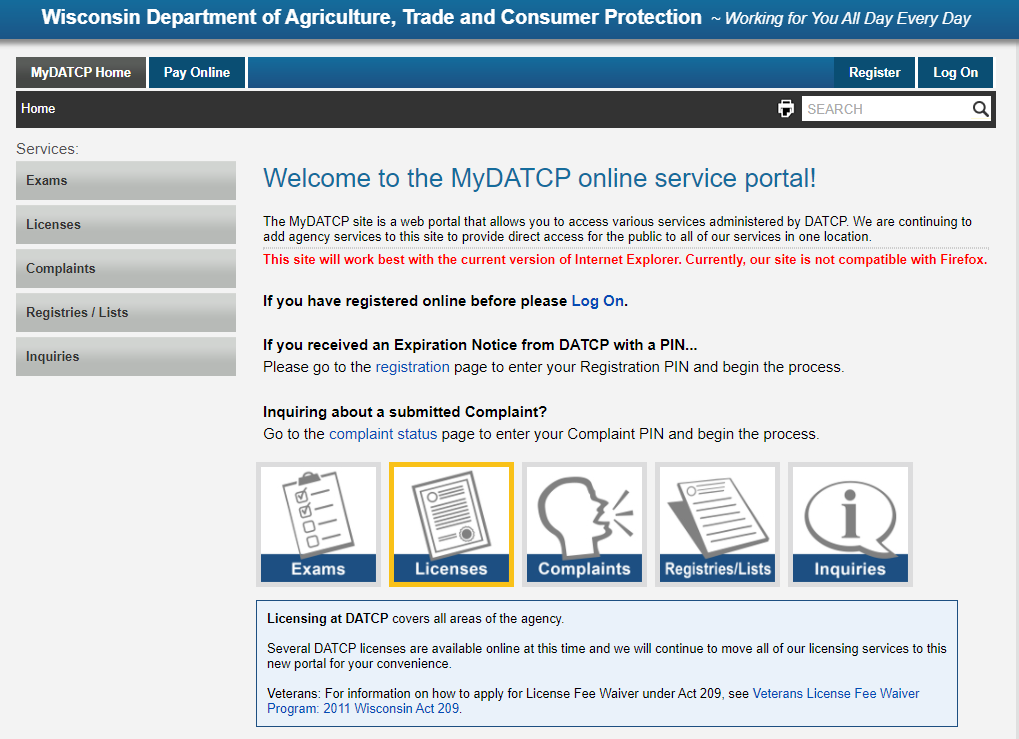 MyDATCP online service portal can be used to renew your nursery license by the February 20 deadline
Stump-Cultured Christmas Trees: A Model of Sustainability and Efficiency from Western Wisconsin
A wide variety of Christmas tree field management styles can be seen when inspecting Christmas tree fields throughout Wisconsin. An example of a very sustainable practice is known as stump-cultured Christmas tree production. In many northern counties of Wisconsin, where native balsam fir trees are found, families of Christmas tree growers have produced stump-cultured Christmas trees over several generations. Most of these Christmas tree fields are wild-grown, native balsam fir trees that have naturally seeded and grown. The Christmas tree farmer comes in to shear them into that capital A-shaped form that buyers want. By leaving a row or two of lower branches when cutting down a Christmas tree, the remaining branches will send up shoots that use the energy stored in the roots to form a new tree faster than the original one grew. Eventually the less-than-perfect shoots get cut away, leaving the straightest, most vigorous one to become that next Christmas tree, typically in about half the time it took before. By leaving the lowest branches intact when cutting this next tree, the stump culturing process can continue for several more tree generations on the same stump. Inspector Konnie Jerabek has noticed instances where growers have harvested four Christmas trees off the same stump over 20 years or more. Boughs can also be harvested from stumpage to supply the growing market for local material in wreaths, porch pots, and other holiday décor.
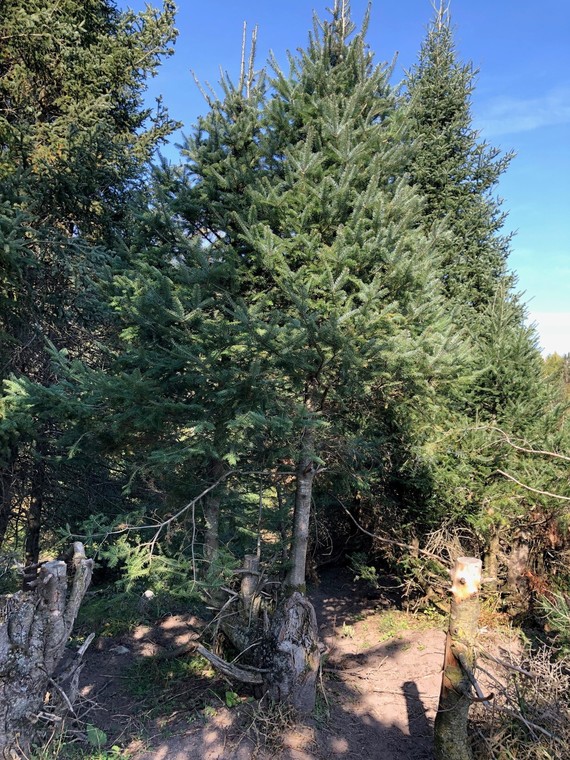 Image of stump cultured Christmas tree
Don't Bring Forest-Killing Pests on Firewood to the Cabin This Year
Heading to your deer camp for hunting? Please recognize that firewood can transport non-native, invasive insects and diseases that can devastate forests and degrade wildlife habitat. For instance, transporting firewood from oak-wilt-killed trees could inadvertently move oak wilt into new areas. If oaks become infected, the fungus can spread from tree-to-tree and kill oaks, especially red oaks, relatively quickly. Dead oaks result in a loss of acorn production, and will lead to fewer animals like deer and turkey visiting the area. Lymantria dispar is another hitchhiking pest that can easily move on firewood. If unburned firewood contains egg masses, they will hatch in the spring and create new infestations of this voracious leaf defoliator. Hungry caterpillars lead to stressed trees, which can also reduce mast production and degrade wildlife habitat. Help preserve trees and wildlife habitat by buying DATCP-certified firewood or by using only local firewood.
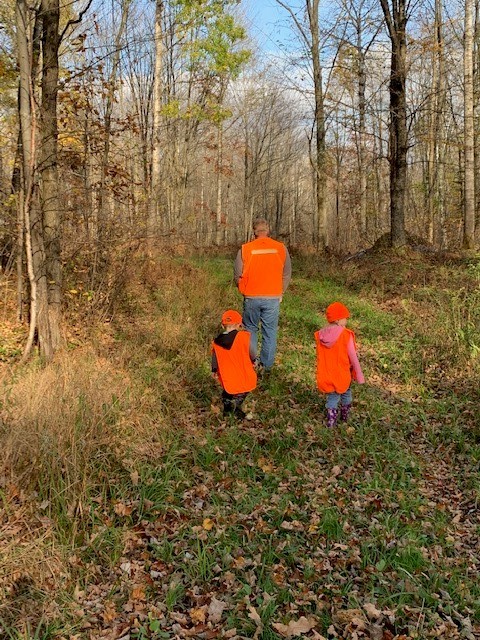 Wisconsin forest with family in blaze orange hunting clothing
Pine Pitch Midge Observed on White Pine
While inspecting Christmas trees this past September in Taylor County, inspectors observed white pine with yellowing needles and oozing pitch along trunks due to insect feeding at the base of branches on mid to upper whorls of the tree. Upon dissection of pitch masses, several small (¼”), bright pink-orange larvae were detected. DATCP's Bureau of Plant Industry lab identified the larval samples as pine pitch midge (Cecidomyia candidipes). First confirmed in Wisconsin in 1997, C. candidipes had been detected in Clark, Chippewa, Door, Dunn, Eau Claire, Iowa, Jackson, and St. Croix counties prior to the Taylor County detection in 2021. Reported distribution also includes areas of Canada from Quebec to Ontario, south to Illinois and east to Maryland. Christmas tree producers should note that pitch masses on white pine can be made by Zimmerman pine moth, fir coneworm, or pine pitch midge. To correctly identify the pest, you will need to get sticky, by gently digging through the pitch mass to distinguish small, bright orange midge larvae from larger purplish pink caterpillars or brown pupae of Zimmerman pine moth or fir coneworm. Unlike these caterpillar pests, pine pitch midge larvae leave the pitch mass to pupate in white cocoons on nearby needles. Growers may observe yellow needles on impacted branches and oozing pitch masses on the trunk of the tree. Large populations can even girdle trees. Because pine pitch midge populations fluctuate greatly, management may be unnecessary. If control is warranted, target adults using a contact insecticide by monitoring emergence, by collecting an infested branch cutting in a plastic bag in early spring (stored at room temperature, out of direct sunlight). Systemic control may have limited effects due to pine pitch midge's protected feeding habits.
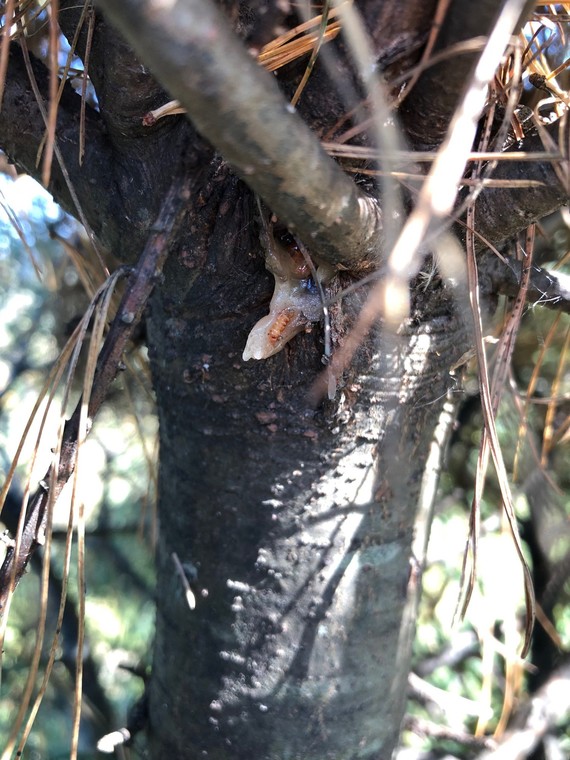 Pinkish orange pine pitch midge on white pine
Statewide Potato Survey Underway
In 2020, potato mop top virus (PMTV) was detected for the first time in a Wisconsin grown potato tuber. This virus is of economic importance to potato producers as it can compromise the quality of potato tubers. In response to the detection of this virus, DATCP's Bureau of Plant Industry applied for a specialty crop block grant in order to conduct a two-year statewide survey for PMTV and its vector, powdery scab (Spongospora subterranea f. sp. subterranea). The last time DATCP surveyed for these pathogens was in 2009 and 2010. The current survey effort will update knowledge of disease distribution in the state, highlight areas of risk and allow growers to develop proactive management strategies to protect their crops. The first phase of this survey is now underway with tubers being collected from potato storage facilities and tested for the presence of PMTV and powdery scab. The second phase of the survey will occur in fall 2022 with collection of soil samples from potato fields to test for the presence of PMTV and powdery scab. For current survey information and county level survey results please check DATCP's potato survey reports. If you are a grower and interested in participating in this survey, contact Sam Fieweger, lab director, at sam.fieweger@wisconsin.gov.
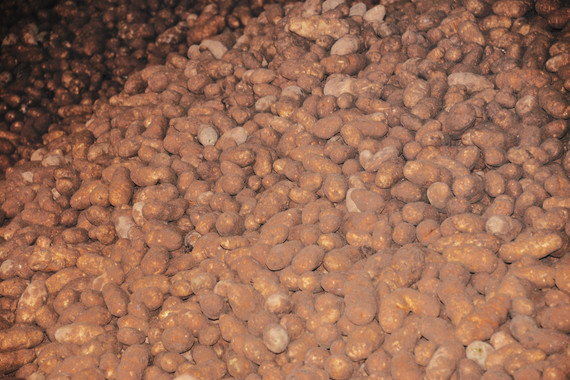 Learn More
For more information about Wisconsin's Nursery Program, visit DATCP's Nursery and Christmas Tree Program webpage.
Division of Agricultural Resource Management | Bureau of Plant Industry
Having trouble viewing this email? View it as a Web page.
|